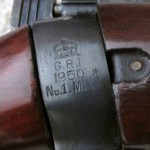I cannot look at a .303 SMLE (Short, Magazine, Lee-Enfield) without having the stereotypical image of an Indian constable pop to mind — overweight, disillusioned, possibly a trifle dishonest, but often brave when it counts the most. If he’s armed, there’s a good chance that he carries a .303 SMLE. You may have seen him on the street, at the airport, railway station, so many places. In my mind’s eye, he treats his rifle as though it is unloaded; I also suspect that it wouldn’t pass a thorough arms inspection.
The constable’s SMLE was one of the 20th century’s outstanding military rifles and surely the one with the longest service record. Adopted by the British Army at the turn of the century, the .303 Lee-Enfield saw service in both world wars and countless conflicts around the world. During World War I alone, more than 2,000,000 SMLEs were made at the Royal Small Arms Factory at Enfield Lock, Middlesex (Reynolds 1960: 180). These rifles would eventually be manufactured at factories in England, India, Australia, and even a few in the United States. Production changed to the 7.62 cartridge in the 1960s, and the last Enfields were made in the early 1970s.



